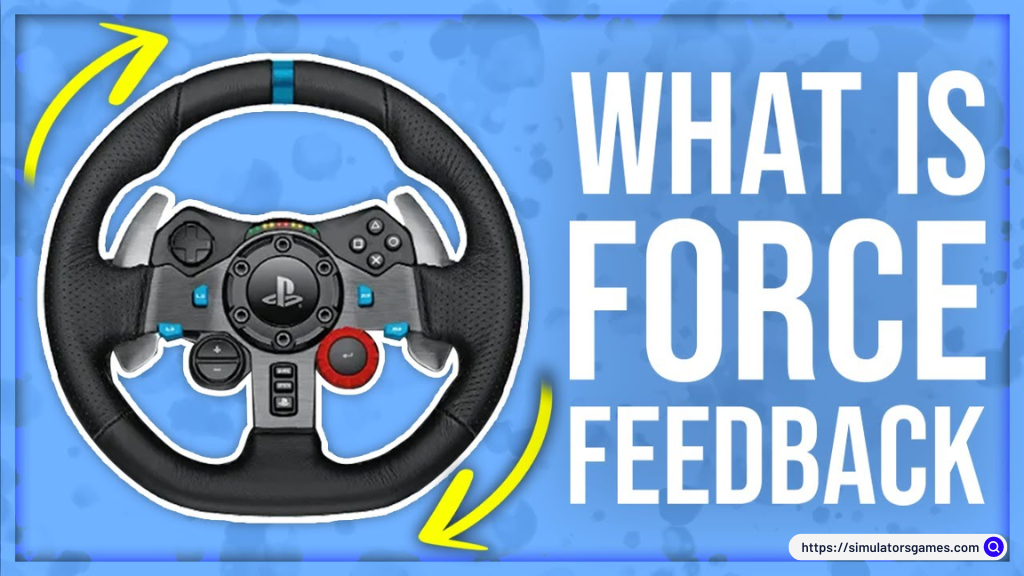As you delve deeper into the world of gaming, you may have come across force feedback. This nifty technology can enhance your gaming experience by providing haptic feedback to create a sense of realism. In this blog we learn about what is force feedback.
For racing games, force feedback is particularly crucial in steering wheels. Where it replicates the physical forces you would feel in a real car. A good force feedback steering wheel aims to simulate a lifelike driving experience.
Emulating the resistance and vibration you would experience when behind the wheel of an actual car. Different driving surfaces are taken into account, so expect to feel varying degrees of resistance and vibration when driving on mud, gravel, or snow.
Don’t let mediocre controllers hamper your gameplay. By upgrading to a force feedback steering wheel, you’ll have greater control over your car, giving you the ultimate gaming experience.
Mechanics of Force Feedback
When you’re behind the wheel of a force feedback controller, you may be wondering how exactly it works to give you such a realistic experience. Essentially, the controller is outfitted with small motors that produce vibrations and resistance that simulate the feeling of different surfaces or actions within the game.
For example, if you’re navigating a road with many potholes, the wheel will vibrate and offer resistance with each bump you encounter. Similarly, when you make a sharp turn, the resistance will increase to reflect the added effort required in the game.
To achieve these effects, game developers utilize the Microsoft DirectInput API, which provides a library for creating force feedback experiences for input devices such as pedals, steering wheels, and handbrakes.
This allows developers to create a more immersive gaming experience that puts players in the driver’s seat like never before. Overall, force feedback is an impressive technological achievement that adds a new level of realism to the gaming experience.
With its precise simulation of various surfaces and actions, it can transport players into a whole new world and provide hours of immersive entertainment.
Different Kinds of Steering Wheels with Force Feedback
Looking to upgrade your racing game setup with a steering wheel that provides force feedback? We’ve got you covered with a breakdown of the various options available on the market today.
1. Gear Drive
For individuals looking to try out a steering wheel with force feedback technology without breaking the bank, the gear drive option is often the go-to choice. This type of wheel works by utilizing a set of gears that are connected to an electromotor, delivering the force feedback experience drivers desire.
However, the noise generated by these gears as they turn can be disruptive to some users. Nevertheless, the gear drive remains a reliable option for anyone wanting to explore the benefits of force feedback steering without making a significant financial investment.
2. Belt Drive
If you’re in the market for a force feedback wheel, you may come across two main types: gear drive and belt drive. While both offer resistance, the belt drive tends to generate a stronger force feedback effect. However, it is also more expensive.
The good news is that belt drive strikes the perfect balance between price and quality, providing a premium experience without breaking the bank. Just keep in mind that the belt itself will require occasional maintenance, as wear and tear can lead to stretching and the need for replacement.
Don’t let this deter you from choosing a belt drive steering wheel, though. With its superior force feedback and mid-range price point, it’s a popular choice among serious racing game enthusiasts.
3. Direct Drive
For those looking to take their sim racing to the next level, direct-drive steering wheels are the way to go. With no gears or belts to rely on, these wheels connect directly to an electromotor for the smoothest and most realistic force feedback possible.
Of course, this level of performance doesn’t come cheap – some models can cost well over a thousand dollars. But if you’re committed to your hobby and demand the best, a direct drive wheel is worth the investment.
Force Feedback Clipping
Have you ever experienced your steering wheel maxing out the force feedback effect it can create? This phenomenon is known as force feedback clipping. Essentially, clipping occurs when your controller reaches its limit in producing new force feedback effects.
For example, let’s say you encounter a gravel patch while driving. Your steering wheel may max out on force feedback effects, leaving you with no additional sensations. Force feedback clipping can happen for a variety of reasons, but it is commonly caused by excessively high steering wheel settings.
Finding the optimal settings for your wheel will improve your experience and prevent this issue from occurring. It’s worth noting that different tracks will require different adjustments due to varying loads.
This may sound technical, but it’s important to understand force feedback clipping so that you can optimize your driving experience. It’s essential to find the sweet spot in your settings that works for you and provides the best possible sensation when driving.
So next time you’re hitting the tracks, make sure to adjust your settings accordingly to avoid force feedback clipping.
Are you contemplating buying a force feedback racing wheel but wondering if it’s really necessary?
Well, that all depends on your level of passion for sim racing. If you’re just starting, we’d advise sticking to a basic steering wheel without force feedback or even using your Xbox controller to connect to your PC.
Why? Because, let’s face it, setting up a racing sim can be a pricey endeavor. Even the cheaper versions of force feedback steering wheels can cost upwards of $200 to $300, and that’s without additional extras like pedals or handbrakes.
Unless you’re a hardcore fan, it’s probably not worth the investment.
Conclusion
Force feedback technology adds a realistic and immersive element to gaming experiences, especially in racing games where it can replicate the physical forces felt when driving a real car.
Different types of steering wheels, such as gear drive, belt drive, and direct drive, offer varying levels of force feedback. It’s important to find the optimal settings for your wheel to avoid force feedback clipping.
While force feedback wheels can be pricey, they’re worth the investment for serious sim racing enthusiasts. However, beginners may want to start with a basic steering wheel or Xbox controller until they’re more invested in the hobby.
Also Read: Top 5 Best Racing Simulator Games






